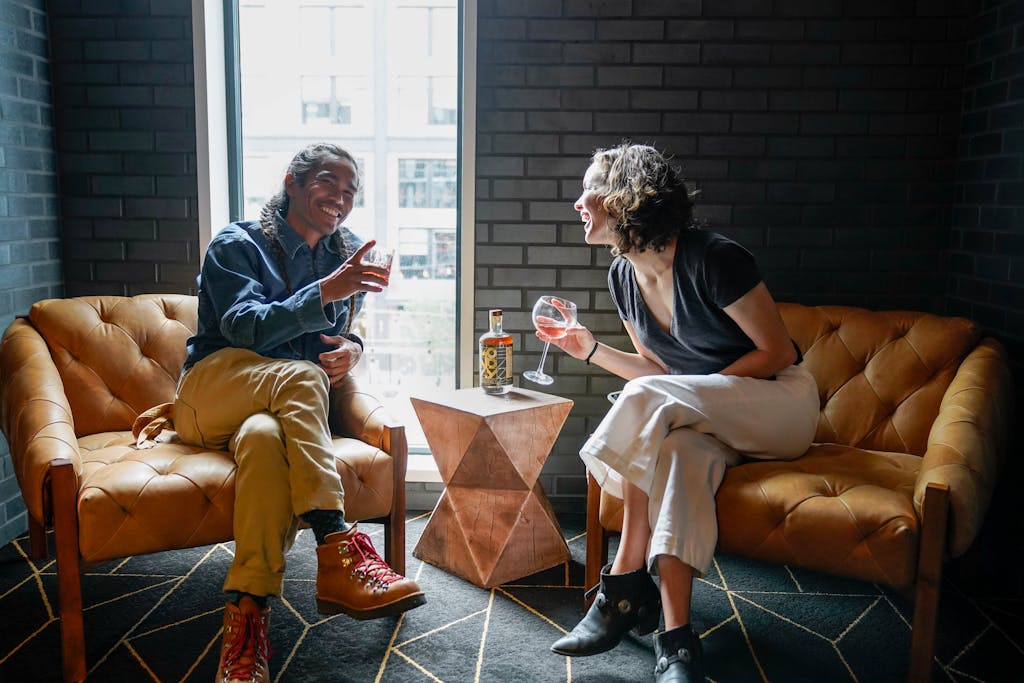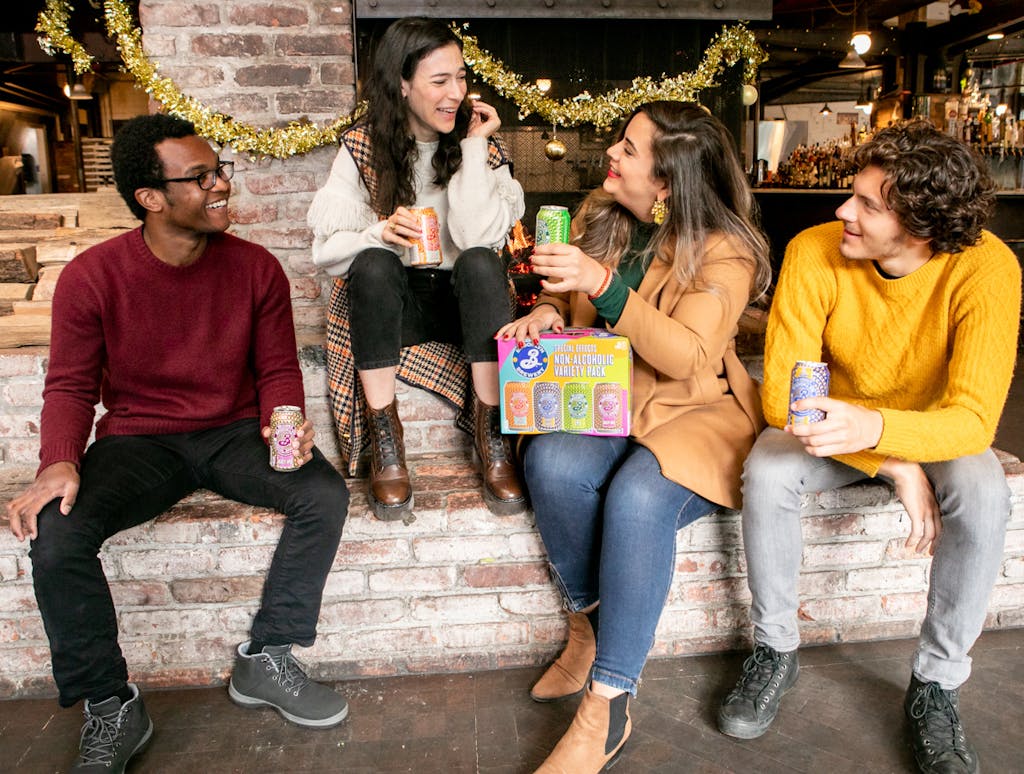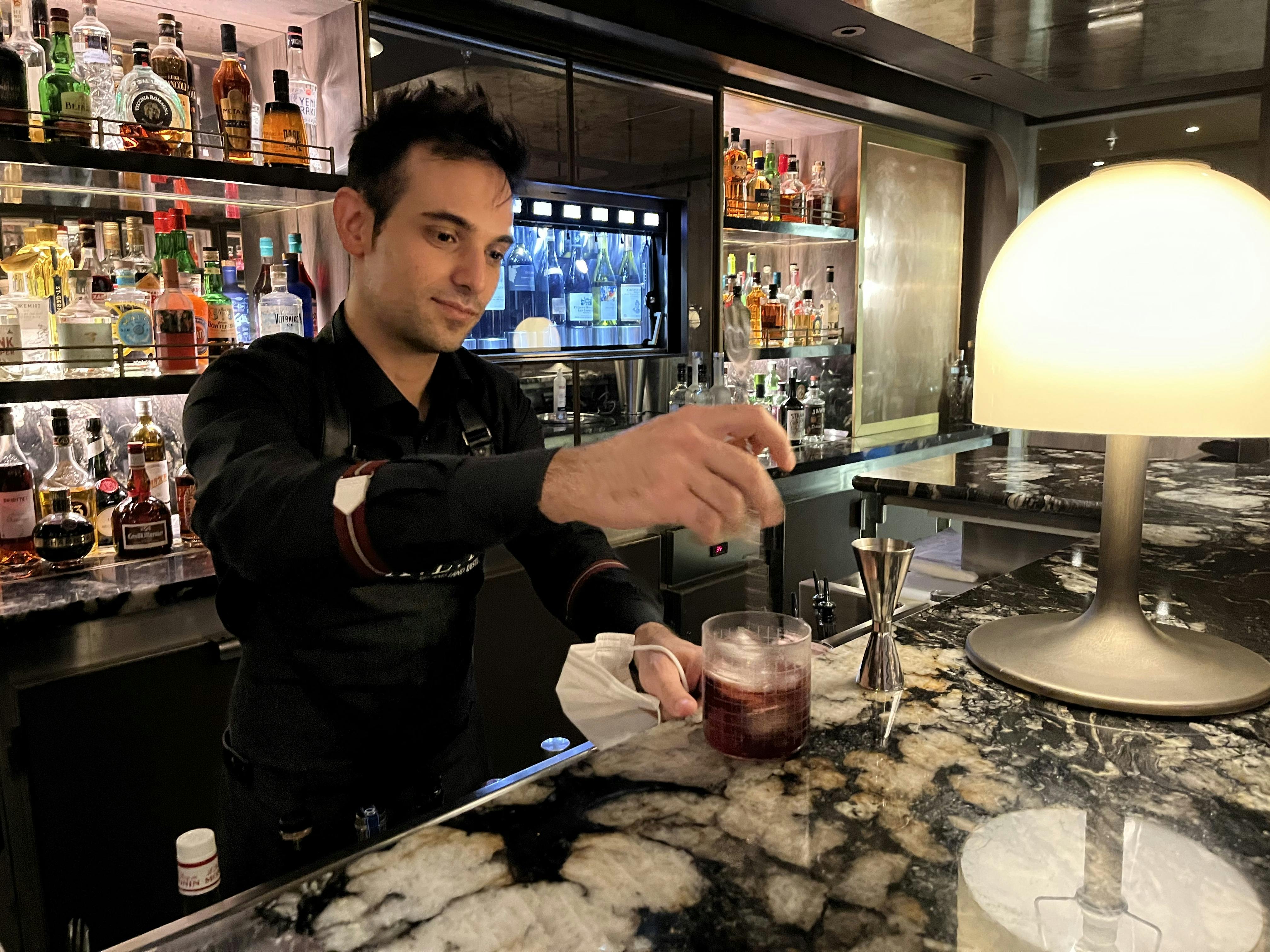A Guide to Non-Alcoholic Drinks: Travelers Can Now Enjoy More Options
“We’re way beyond the cranberry-and-soda, my friends!” Adam Smid, the bartender at the S.A.L.T. Bar on Silversea Cruises’ Silver Moon, said with a laugh. He raised his glass for a toast, challenging us to broaden our views of non-alcoholic drinks.
I took a sip from the beverage before me, and found it not just delicious but remarkably close to the “real” thing. It was a Negroni, so to speak: bracing, bittersweet, redolent of burnt orange and botanicals, with all the herbaceous kick of the original … but it was missing one key ingredient.
“Wait,” I said. “Are you sure there’s no booze in this?”
Smid grinned like he’d just pulled off a card trick. “Not a drop,” he replied.
I’d met Adam my first night aboard Silver Moon, where he oversees the intimate S.A.L.T. Bar, part of Silversea’s immersive S.A.L.T. culinary program. Handsome, affable and a genius at crafting cocktails, he won me over immediately. My wife and I wound up ending each night perched at his marble bartop. That first night, I’d asked for something non-alcoholic, and our talk turned to the evolving world of booze-free drinks.
It turns out that Smid and his team had been busy devising a host of recipes for non-alcoholic drinks (dubbed n/a) — partly because more guests were requesting them, but also because, like any curious alchemists, the bartenders couldn’t resist a challenge.
Which is how we found ourselves with Smid later that week at the Observation Library, doing something none of us would’ve imagined doing 10 or 15 years ago: tasting an impressive range of zero-proof cocktails. (And at 11 a.m., no less.)
“It’s still a new field, with a lot of potential,” he told us. “But really, bartenders have struggled with this forever: How do you serve drinks to guests who don’t drink?”
Today, as the so-called “sober-curious” movement gathers steam, more of us are moderating our intake, if not forgoing alcohol entirely.
Sober-curious movement gains steam
How, indeed? Today, as the so-called “sober-curious” movement gathers steam, more of us are moderating our intake, if not forgoing alcohol entirely. A 2021 NielsenIQ poll found that 22 percent of respondents were trying to cut back on the booze.

The temperance trend spans all generations, too. I know plenty of fellow 50-somethings who’ve dialed it down for purely practical reasons. As we age, a night out — or even a shared bottle of wine over dinner at home — has more consequences, and many of us are just tired of being tired. Yet we still eat out at restaurants, gather in bars, go to parties where booze flows freely. So why, for ages, did we have to settle for a desultory seltzer-and-lime?
And then there’s this: For some of us, going out isn’t just an adventure, it’s also our job. I’ve written about food and travel my whole adult life, and always had an on-and-off relationship with alcohol, before giving it up altogether five years ago. When your profession revolves around eating and drinking, moderation is a constant battle; it certainly was for me. Often I would forgo booze for weeks at a time, just to reset — yet I continued reporting on restaurants, where wine pairings and craft cocktails were considered an essential part of the experience. And booze-free options? Back then it was hardly worth asking.
I remember an otherwise lovely meal at a bistro in Lyon, circa 2003, where I discreetly asked the sommelier if he had any non-alcoholic beer. He looked at me like I’d set fire to his Bruno Magli shoes. “I can bring you…un Amstel Light,” he spat back. Thanks, pal, not quite what I was after.
Alas, exchanges like this were pretty much the norm then. Until recently, non-drinkers met the same indifference or derision that vegan, lactose-intolerant and gluten-free consumers were used to back in the culinary dark ages. The attitude came from restaurant waitstaff, party hosts, even your own dinner companions: a collective Uggghh, this guy again: Get over yourself!
Tasting that faux-Negroni with Smid — and watching him serve plenty of other non-alcoholic drinks that week on the Silver Moon — it struck me how mainstream the zero-proof trend had become, and how the offerings had vastly improved in just a few years.

I’m exaggerating when I say there were no non-alcoholic options back in the day. There just weren’t many good ones. “Near-beer” was a wan, watery imitation, hardly worthy of the name. Alcohol-free wines tasted like overripe grape juice. Hardly anyone had cracked the code of non-alcoholic liquors. At most bars and restaurants, the best one could hope for was soda-fountain ginger ale with unmelted ice and decent bubbles. Even that was rare.
Starting around a decade ago, though, things began evolving at a rapid pace. Non-alcoholic “spirits” appeared in bars and fancy food shops. Seedlip, an early non-alcoholic pioneer from England that debuted in 2015, bottled its botanical-infused elixirs with handsome labels evoking artisanal gins — and sold them at a similar price. (I winced the first time I paid $37 for a bottle of Seedlip’s lemongrassy Grove 42, but for a while it became my go-to drink, mixed with citrus and Fever Tree tonic.)
Meanwhile, winemakers like Leitz, from Germany’s Rheingau region, began making very good non-alcoholic Rieslings and sparkling rosés via a process of “de-alcoholization,” which allows the wines to retain more of their original fermented character.
And of course, the non-alcoholic beer market has absolutely exploded — on both the big-brand level (Heineken, Beck’s, Budweiser) and, more excitingly, in the craft beer world, as brands like Sam Adams, Lagunitas and Brewdog roll out booze-free options. The upstart Athletic Brewing Company makes only non-alcoholic brews, in more than a dozen styles, and does a bang-up job with nearly all of them.
Lately, we’ve even seen a spate of non-alcoholic bottle shops — liquor stores without liquor — opening across the U.S. and Europe. There’s one in my Brooklyn neighborhood that I pop into regularly for zero-proof wines, spirits, beers, and mixers — and every week, it seems, a half-dozen new brands have appeared on the shelves.
Clearly, there’s something in the water, and it’s definitely not alcohol. Indeed, some of the most respected people in the drinks business are now getting in on the non-alcoholic market — including many who would never before have considered it.
How one brewmaster created a non-alcoholic Brooklyn Brewery beer

My friend Garrett Oliver is the brewmaster of Brooklyn Brewery, one of the country’s top craft beer brands. Having literally written the book on the subject — the 960-page Oxford Companion to Beer — Garrett is as informed about beer as anyone on the planet. When I got back to New York, I gave him a call, to ask how he wound up playing an unexpected role in the n/a scene.
Like the borough itself, Brooklyn Brewery has a whole lot of fans abroad — which is why it agreed to try its hand at a booze-free product. Back in the mid-2010s, Carlsberg (Brooklyn’s overseas distributor) asked Garrett and his team to come up with a non-alcoholic Brooklyn beer they could sell in Europe, where the n/a category was growing.
“To say I was skeptical is an understatement,” Garrett recalls with a laugh. “Non-alcoholic beer was anathema to everything I’d worked for. I was honestly the last person you’d ask to make it, let alone drink the stuff!”
But after much trial and error, the team came up with a beer that Garrett could get behind. Brooklyn’s first Special Effects n/a release — a dry-hopped lager made with Citra and Amarillo hops — launched in Europe in 2018, and arrived stateside a year later. Its critical and commercial success helped elevate the profile of n/a beer in general. Suddenly, it was safe for the cool kids to join the game.
Initially, Garrett’s goal was simply “to make something that beer geeks would approve of, and maybe even drink themselves.” This explains the hop-forward character and piney overtones of Special Effects, reminiscent of the best craft lagers. Malty, bready, bitter in the best way, it’s a beer that even a hardcore beer nerd could love. In fact, says Garrett, according to the company’s market studies, many Special Effects drinkers still drink “actual” beer as well; they just want a tasty option to alternate with the real stuff, whether they’re pacing themselves on a night out or enjoying a crisp lager at lunch.
Against all expectations, Garrett himself is now one of them.
“At my age, I gotta hit the gym every night or everything falls apart,” he laughs. “Now if I’m grabbing a drink with the brewery team after work, I’ll have a Special Effects, so I can still make it to my workout.”
So he no longer sees non-alcoholic drinks as heretical?
“Look, I ferment things for a living. I’ve devoted my career to this. But I also saw n/a beer as an interesting puzzle to solve,” says Garrett. “I’d compare it to, say, vegan cooking. To make vegan food complex and exciting, you have to really know what you’re doing. It takes a whole other level of skill, almost more than non-vegan cooking. Same with n/a beer. It’s like making a croissant without butter. If you can do that — and people actually want to order it — you’re golden.”
Want to enjoy a sober cruise? Wet your whistle by reading Peter Lindberg’s 5 Essentials for Your Spirit-Free Bar.
